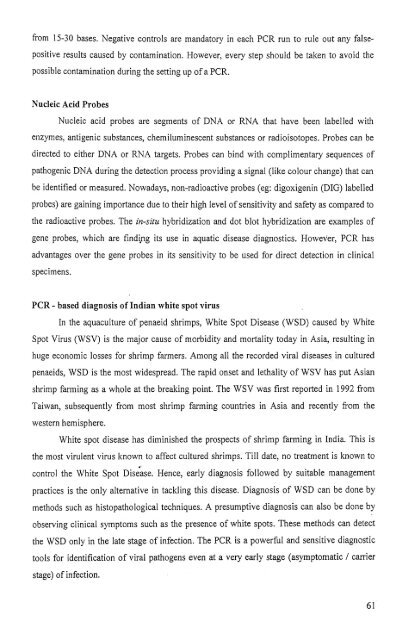, Diagnosis an-&& of Shrimp Diseases - Central Institute of ...
, Diagnosis an-&& of Shrimp Diseases - Central Institute of ...
, Diagnosis an-&& of Shrimp Diseases - Central Institute of ...
- No tags were found...
Create successful ePaper yourself
Turn your PDF publications into a flip-book with our unique Google optimized e-Paper software.
from 15-30 bases. Negative controls are m<strong>an</strong>datory in each PCR run to rule out <strong>an</strong>y false-positive results caused by contamination. However, every step should be taken to avoid thepossible contamination during the setting up <strong>of</strong> a PCR.Nucleic Acid ProbesNucleic acid probes are segments <strong>of</strong> DNA or RNA that have been labelled withenzymes, <strong>an</strong>tigenic subst<strong>an</strong>ces, chemiluminescent subst<strong>an</strong>ces or radioisotopes. Probes c<strong>an</strong> bedirected to either DNA or RNA targets. Probes c<strong>an</strong> bind with complimentary sequences <strong>of</strong>pathogenic DNA during the detection process providing a signal (like colour ch<strong>an</strong>ge) that c<strong>an</strong>be identified or measured. Nowadays, non-radioactive probes (eg: digoxigenin (DIG) labelledprobes) are gaining import<strong>an</strong>ce due to their high level <strong>of</strong> sensitivity <strong>an</strong>d safety as compared tothe radioactive probes. The in-situ hybridization <strong>an</strong>d dot blot hybridization are examples <strong>of</strong>gene probes, which are finding its use in aquatic disease diagnostics. However, PCR hasadv<strong>an</strong>tages over the gene probes in its sensitivity to be used for direct detection in clinicalspecimens.PCR - based diagnosis <strong>of</strong> Indi<strong>an</strong> white spot virusIn the aquaculture <strong>of</strong> penaeid shrimps, White Spot Disease (WSD) caused by WhiteSpot Virus (WSV) is the major cause <strong>of</strong> morbidity <strong>an</strong>d mortality today in Asia, resulting inhuge economic losses for shrimp farmers. Among all the recorded viral diseases in culturedpenaeids, WSD is the most widespread. The rapid onset <strong>an</strong>d lethality <strong>of</strong> WSV has put Asi<strong>an</strong>shrimp farming as a wliole at the breaking point. The WSV was first reported in 1992 fromTaiw<strong>an</strong>, subsequently from most shrimp farming countries in Asia <strong>an</strong>d recently from thewestern hemisphere.White spot disease has diminished the prospects <strong>of</strong> shrimp farming in India. This isthe most virulent virus ltnown to affect cultured shrimps. Till date, no treatment is known tocontrol the White Spot Disease. Hence, early diagnosis followed by suitable m<strong>an</strong>agementpractices is the only alternative in tackling this disease. <strong>Diagnosis</strong> <strong>of</strong> WSD c<strong>an</strong> be done bymethods such as histopathological techniques. A presumptive diagnosis c<strong>an</strong> also be done byobserving clinical symptoms such as the presence <strong>of</strong> white spots. These methods c<strong>an</strong> detectthe WSD only in the late stage <strong>of</strong> infection. The PCR is a powerful <strong>an</strong>d sensitive diagnostictools for identification <strong>of</strong> viral pathogens even at a very early stage (asymptomatic / carrierstage) <strong>of</strong> infection.
















